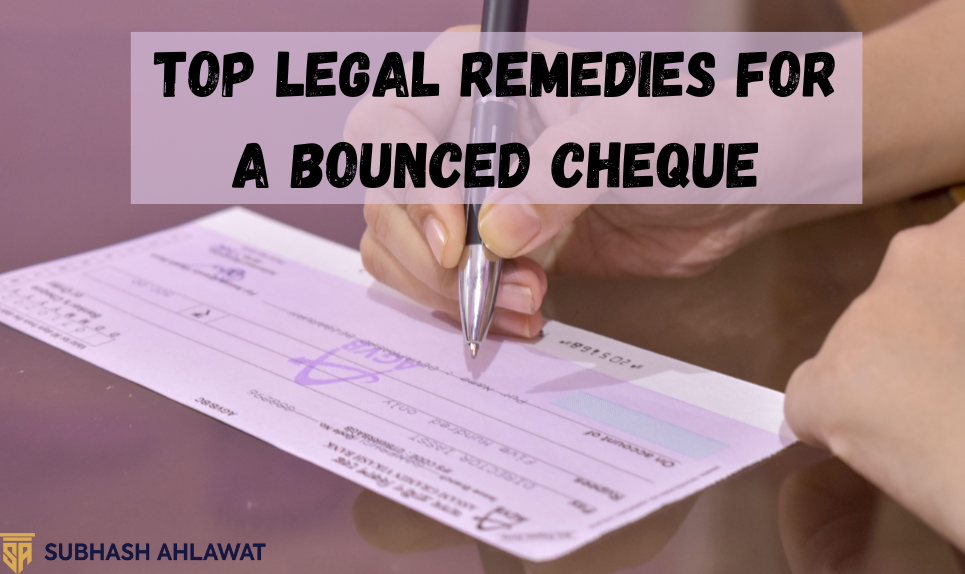Top Legal Remedies for a Bounced Cheque

In today's time, a lot of frauds are happening with people, one of them is related to cheque bounce. The problem of cheque bounce has put people in a lot of trouble, be it businessmen or common people. Whenever your cheque bounces it affects your credibility. Financial status and sometimes even personal relationships are negatively affected. The Indian legal system has specific laws and procedures to deal with cheque bounce which can be followed to protect the rights. In this blog we will discuss the top legal remedies for bounced cheques.
What is a Cheque Bounce?
First of all let us understand what is called cheque bounce. When a cheque is given for payment and is declared 'dishonored' or 'bounced', in that case we call it a bounced cheque. There can be many reasons for a cheque to bounce, such as insufficient funds, signature mismatch, overwriting or account closure. The Indian judicial system takes the issue of cheque bouncing seriously, which is why there is a provision for penalties under Section 138 of the Negotiable Instruments Act, 1881.
Insufficient funds: The most common reason for cheque bounce is insufficient funds. Whenever there is less money in an account, the bank does not clear the cheque.
Signature mismatch: The cheque signature does not match the actual bank signature, or the cheque bounces due to a mistake by the authorized signatory.
Overwriting/Alterations: If any unauthorized overwriting and alterations are noticed on the cheque, the bank may reject it.
Expired Cheque: Validity of cheque is 3 months, exceeding this makes the cheque invalid.
Account Closed/Frozen: If the issuer has closed his account, or the account is frozen for any legal reason, the cheque will bounce.
Consequences of Cheque Bounce
Bounced cheque affects your credit. Due to frequent cheque bounce cases, banks and financial institutions do not trust such customers much. If the check bounces, a criminal complaint can be filed against the issuer and the issuer could end up going to jail or paying a fine.
Criminal Liability under Section 138 NIA
Negotiable Instruments Act Section 138 states that if your cheque bounces and the issuer has not made the payment within 15 days, you can file a complaint against the issuer under Section 138 NIA. The punishment under Section 138 is imprisonment up to two years, fine up to twice the amount of the cheque, or both imprisonment and fine.
Civil liability
Along with criminal liability, you can also file a civil suit to recover your money. In this you are more likely to get the principal amount along with interest and legal costs.
Top Legal Remedies for a Bounced Cheque
Let us now understand the legal remedies by which you can protect your rights and regain your rights.
1. Issue a Legal Notice
The first step after a cheque bounces is to send a legal notice to the issuer. As per the Negotiable Instruments Act, you have to send a legal notice to the issuer within 30 days. In the notice you will mention – Cheque bounce information including bounce details, amount, 'Dishonor Memo' received from the bank and demand for payment.
Time limit: When a cheque bounces, the bank gives you a 'return memo'. The time to give notice starts from that day and you have to give notice within 30 days.
Purpose: Sending a legal notice lets the issuer know that you are serious about the amount and also gives the issuer an opportunity to pay its dues without going to court.
Response: After this legal notice, the issuer has a time period of 15 days to make the payment. If the issuer does not make the payment within 15 days, you can file a complaint under Section 138.
Sending a legal notice is very important. Without a legal notice you cannot file a complaint under section 138 NIA. Draft the legal notice correctly and send it with the correct address. Get it prepared from a qualified specialist lawyer like Advocate Subhash Ahlawat, who has 22+ years of experience in handling such cases.
2. File a Criminal Complaint under Section 138 of Negotiable Instruments Act
If the issuer does not make the payment within 15 days even after the legal notice, your next option is to file a criminal complaint.
Procedure:
Drafting the Complaint: Draft the complaint with the help of a cheque bouncing expert advocate. Mention all the relevant facts in the draft like – cheque amount, date, bank details, reason for bouncing and notice details.
Supporting Documents: Along with the complaint you need to attach relevant documents like a copy of cheque, bank dishonour memo, copy of legal notice and proof of sending notice.
Jurisdiction of the Court: The complaint is generally filed in the jurisdiction where the cheque has been presented, i.e. the branch of the bank where the cheque has been presented. As per the Supreme Court guidelines, the case can be filed in the jurisdiction of the payee's bank.
Court proceedings: The court investigates your complaint and if it finds a prima facie case, the court issues summons to the issuer. The trial then begins.
Consequences: If the issuer is found guilty in the case, he may face imprisonment (up to 2 years) or a fine which may be twice the amount of the cheque, or both. The court may also encourage both parties to settle out of court.
3. Filing a Civil Suit (Summary Suit)
Apart from a criminal complaint, you can also file a civil suit to get your money back. In a civil suit, you will get compensation and interest. If your amount is large, then this remedy and process can be very effective.
Summary Suit under Order 37 of CPC: If you file a summary suit in a cheque bounce case, it is a comparatively fast-track process. In this, the defendant (issuer) gets immediate information and if the defendant (issuer) is unable to establish a valid defense then an immediate relief decree is passed by the court.
Relief: If the court grants relief, the amount, interest and legal costs will be paid by the defendant. Your financial losses are compensated through this summary trial relief.
Parallel Proceedings: You can run a criminal complaint and a civil suit in parallel. A criminal complaint provides punishment or compromise and a civil suit allows you to seek actual recovery.
4. Alternative Dispute Resolution (ADR)
Court cases are very time consuming and expensive, which the parties involved choose to settle out of court. The resolution of the case out of court is called ADR (Alternative Dispute Resolution), such as mediation, arbitration or conciliation.
Mediation: In the mediation method both the parties appoint a mediator who facilitates the conversation between the two and finds a way to a solution. If the mediation method is successful, both the parties sign the terms of the agreement.
Arbitration: If you have included an arbitration clause in your agreement or both the parties mutually agree to the arbitration process. In this, the arbitrator is like a private judge who gives an arbitrary decision after hearing the evidence of both the parties.
Conciliation: In the conciliation method, a conciliation officer is appointed who negotiates with both the parties and tries to arrive at an amicable settlement.
The ADR process is much more cost-effective and less time-consuming. Whenever you settle out of court, make sure everything is properly documented so that there are no disputes in the future.
5. Lok Adalat
There is another forum in the Indian judicial system where you get quick results and that is Lok Adalat. In Lok Adalat, mainly petty cases and financial disputes can be settled amicably. If the cheque bounce case is not too complicated then both the parties can approach the Lok Adalat.
Procedure: The court can refer your case to Lok Adalat or you can approach Lok Adalat yourself. In Lok Adalat, retired judges or advocates hear your case and suggest an amicable solution.
Benefits: Speedy settlement, minimal court fees and mutually agreeable results.
Binding Effect: The award given by the Lok Adalat is final and can be appealed against only on very limited grounds.
6. Complaint to Banking Ombudsman (In Certain Cases)
If you feel that the cheque has bounced due to some banking mistake or negligence on the part of the bank, you have the option of complaining to the Banking Ombudsman. This remedy is available to all.
Procedure: You can register your complaint by visiting the official website of RBI or can also send an offline application.
Outcome: If the Ombudsman finds the bank guilty, you will receive compensation.
This process will be related to bank related matters only. If the cheque has bounced due to fault of the original issuer then you will have to resort to section 138 of NIA.
A cheque bounce case is a very serious matter and should not be taken lightly. Keeping in mind the procedure and timelines mentioned above, consult an expert lawyer.


